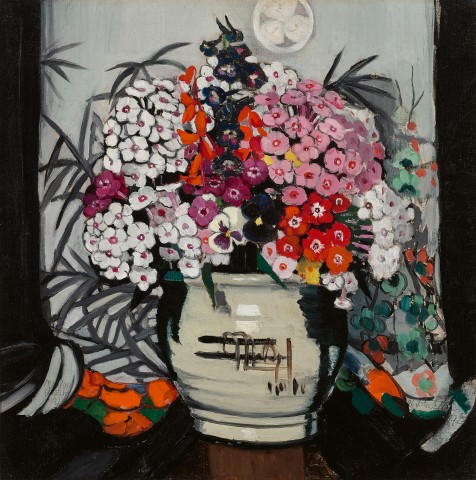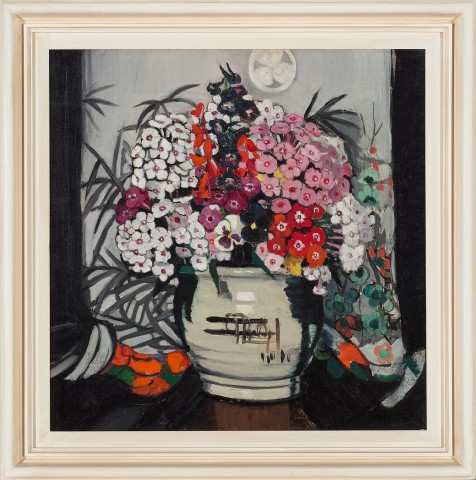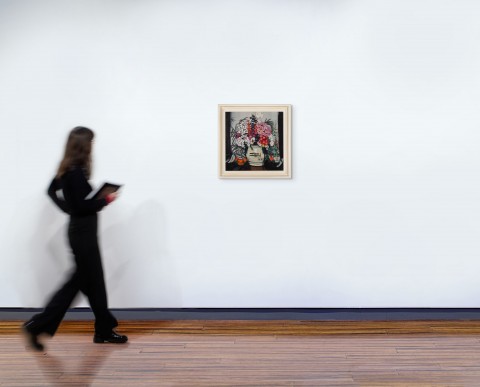PHLOX, 1925
MARGARET PRESTON
oil on canvas
49.0 x 48.5 cm
signed and dated lower left: Margaret / Preston / 1925
signed and dated lower right: M Preston / 1925
Grosvenor Galleries, Sydney
William Buckle, Sydney
Christie’s, Melbourne, 23 March 1978, lot 109A
Adler Fine Art, Sydney
Ivor John Pereira, New South Wales, acquired from the above on 30 June 1979
Estate of the above, New South Wales
Margaret Preston, Grosvenor Galleries, Sydney, 7 – 31 August 1929, cat. 22 (20 gns)
The Art of Margaret Preston, Art Gallery of South Australia, Adelaide, 23 May – 22 July 1980, and touring to the National Gallery of Victoria, Melbourne, and Art Gallery of New South Wales, Sydney, cat. O.14 (label attached to backing verso), lent by Mr & Mrs I. Pereira
‘Art Exhibition. Miss Preston’s Pictures.’, Sydney Morning Herald, Sydney, 7 August 1929, p. 9
‘Mrs. Preston’s Art. Elaborate Tribute.’, Sydney Morning Herald, Sydney, 20 December 1929, p. 10
Ure Smith, S., and Gellert, L. (eds), Margaret Preston, Recent Paintings, Art in Australia, Sydney, 1929, pl. 21
The Home: an Australian Quarterly, Art in Australia, Sydney, vol. 13, no. 9, September 1932, p. 1 (illus.)
The Home: an Australian Quarterly, Art in Australia, Sydney, vol. 15, no. 8, August 1934 (illus. inside cover)
North, I., The Art of Margaret Preston, Art Gallery Board of South Australia, Adelaide, 1980, pp. 46 (illus.), 86
Butler, R., The Prints of Margaret Preston: A Catalogue Raisonné, National Gallery of Australia, Canberra, 1987, p. 311
Margaret Preston Catalogue Raisonné of paintings, monotypes and ceramics, Art Gallery of New South Wales, Sydney, 2005, CD–ROM compiled by Mimmocchi, D., with Edwards, D., and Peel, R., cat. 1925.11
230347 AUGUST The Home, vol. 15, no_cmyk.jpg
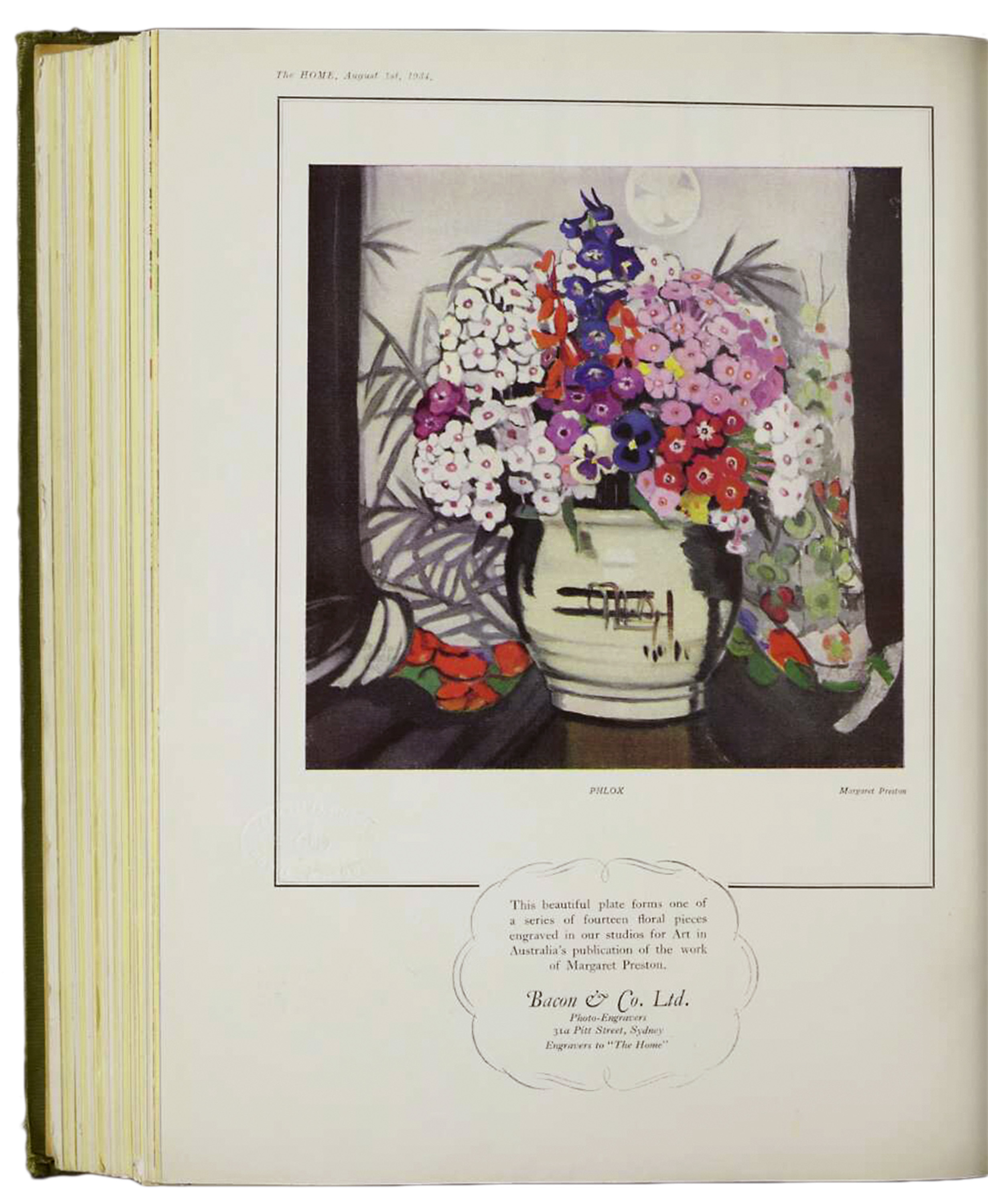
Margaret Preston is without question one of the most important Australian artists of the twentieth century. This view is not simply based on the dynamic beauty of her paintings and woodblocks; it also takes into account her passionate advocacy for modernism, which she honed over many years through exhibitions, articles (twenty-seven alone for Art in Australia and The Home), lectures and curatorial projects. She was also extremely well trained having attended schools and academies in Sydney, Melbourne, Munich, Paris and London before the end of World War One; she also ran her own art school in Adelaide. Preston further succeeded in having her paintings hung during these years at the Royal Academy and New English Art Club in London, and the New Salon in Paris; she was subsequently invited to exhibit at the Carnegie Institute in Pittsburgh. Of particular note, however, is the period she spent at the Musée Guimet in Paris where she studied Japanese and Chinese art, learning ‘slowly that there is more than one vision in art.’1 Following her return to Australia in 1919, her driving ambition was to forge a truly national art based on a combination of European, Asian and Indigenous art, rather than solely European as it had been before her. Phlox, 1925, is a superb example of this ongoing objective, painted in the same year that her imagery firmly began to crystalise these ideas.
230347 Preston Pink Jug (Anemone)_cmyk.jpg
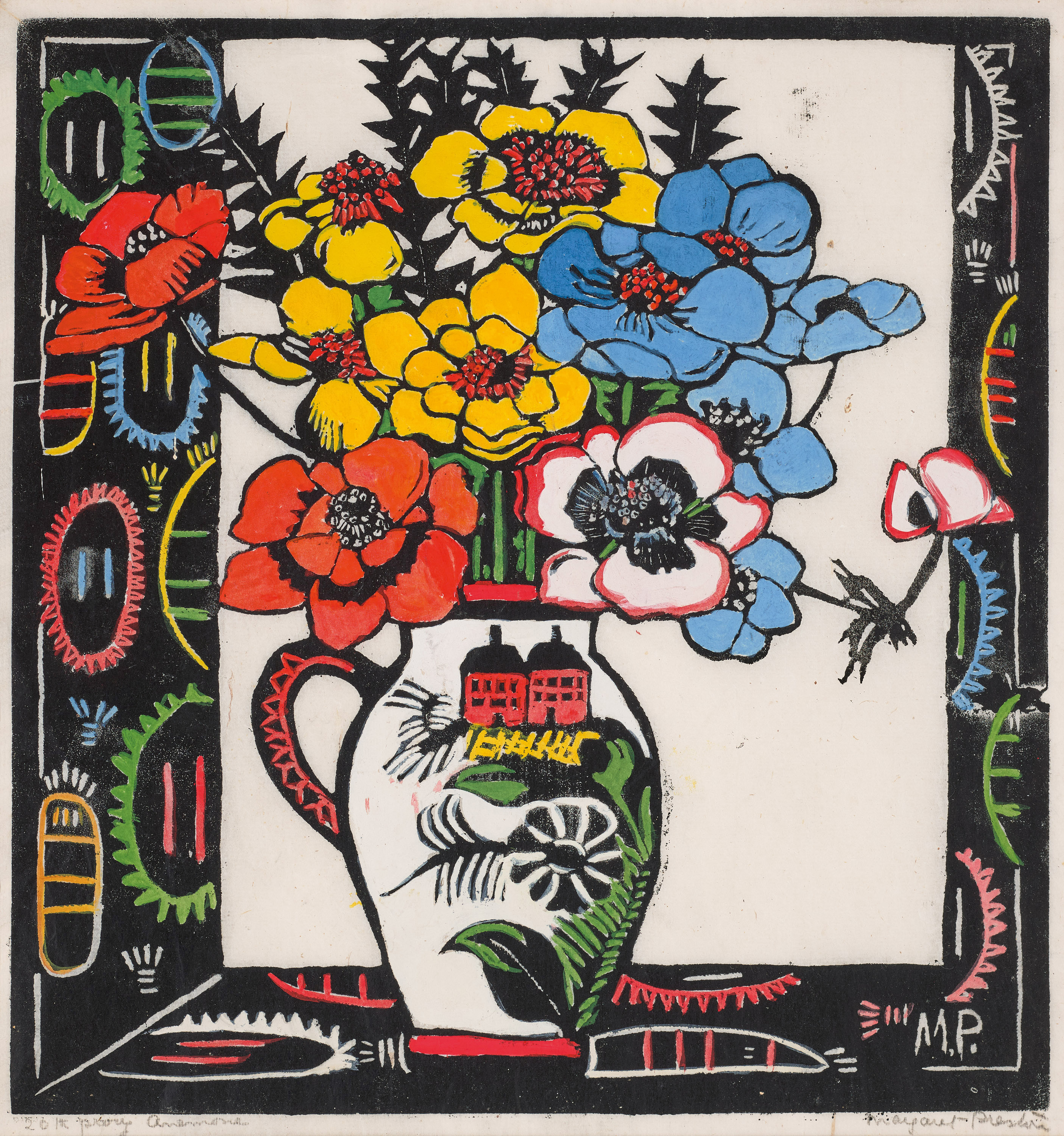
Part of Preston’s strategy was passionately arguing her ideas through journals and lectures, with her inaugural article for The Home – ‘Why I became a convert to modern art’ – being a powerful first salvo, illustrated with the painting The pottery of Gladys Reynell, South Australia, 1922 (Kerry Stokes Collection) and two woodblocks featuring Australian subjects.2 Reynell had studied ceramics alongside Preston in London and subsequently opened her own pottery in Reynella, South Australia; and in the painting, Preston sets one of her friend’s distinctive tea sets on a sharply angled red-lacquered board in front of richly patterned fabrics counter-balanced by Cézanne-esque apples in the foreground. It is a perfectly designed composition through which to explore her ideas. Preston was simultaneously creating some of this country’s most memorable woodblocks, and the shallow space inherent in the process further informed her paintings with the result that deeply recessed perspective became less important to her. Floral still-lifes were a frequent subject, with one of her most famous aphorisms being ‘(w)hy there are so many tables of still life in modern paintings is because they are really laboratory tables on which aesthetic problems can be solved.’3
230347 STUDY IN WHITE_cmyk.jpg
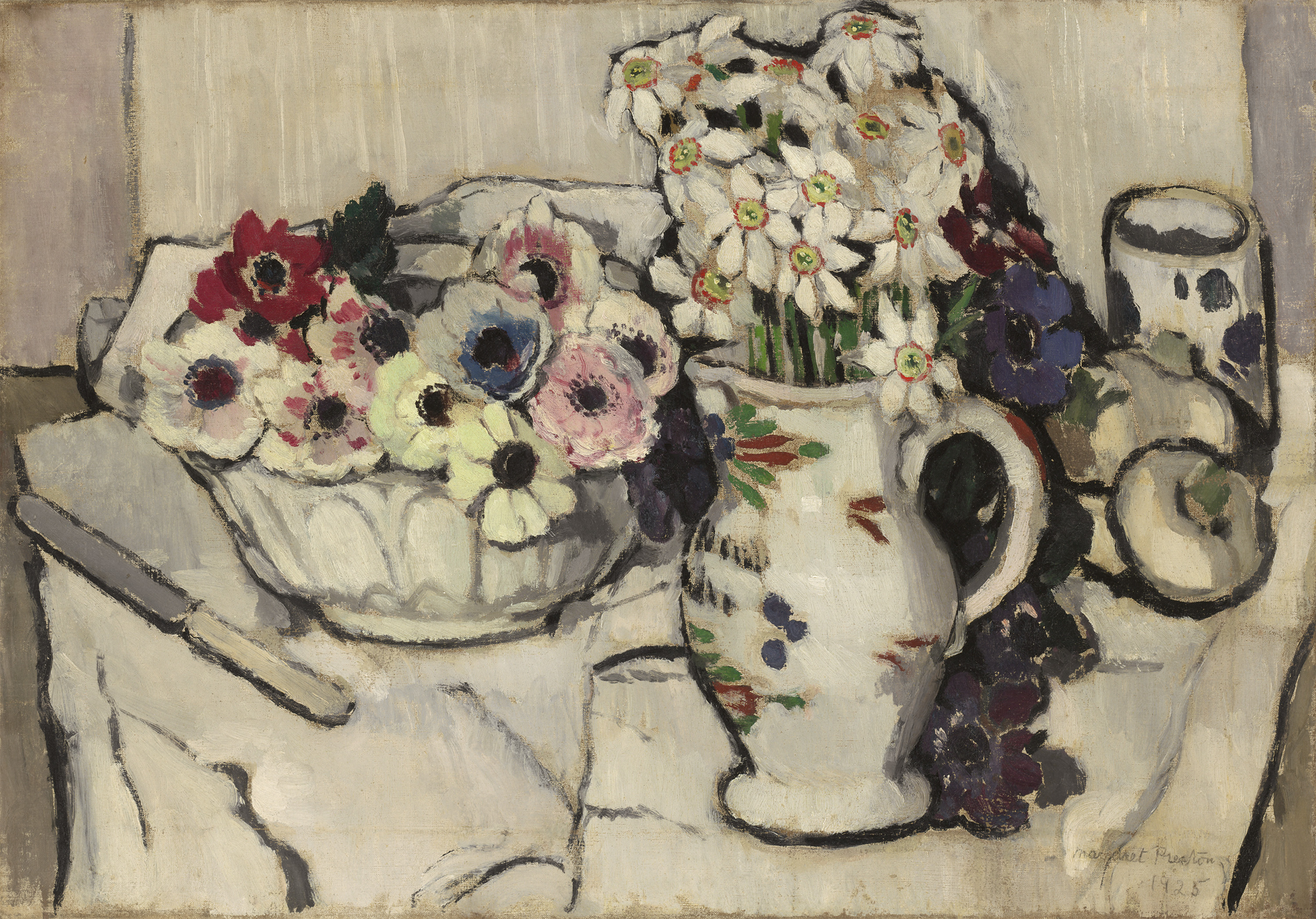
In 1925, the same year that Phlox was painted, Preston created the woodblock Pink jug, anemone (Deutscher and Hackett, 4 May 2022, lot. 2), one of the earliest works that clearly demonstrated her thinking. Presented in a jug decorated with an Asian motif, the anemones are joined by spiky banksia leaves surrounded by stylised motifs based on Aboriginal shields, with the major plane enclosed within a shallow, semi-framed field informed by Cézanne. A similarly ambiguous space exists in Phlox, 1925, with only the reflection in the tabletop signalling the illusion of depth. Painted at her home studio in Park Ave, Mosman, Preston arranges the multi-coloured flowers in a large, centralised pot finished in lead-white glaze with a black, hand-brushed motif. The background is an elegant fabric featuring a stylised cherry (or peach) blossom hovering above silhouetted fern leaves, a pattern which appears to evolve into its own cluster of flowers, partially visible in the ruched cloth below; this, plausibly, was one of the Japanese cloths she had expressed admiration for the previous year.4 When exhibited at the Grosvenor Galleries in 1929, Phlox was rightly singled out for comment by reviewers.
230347 Red White Hibiscuc_cmyk.jpg
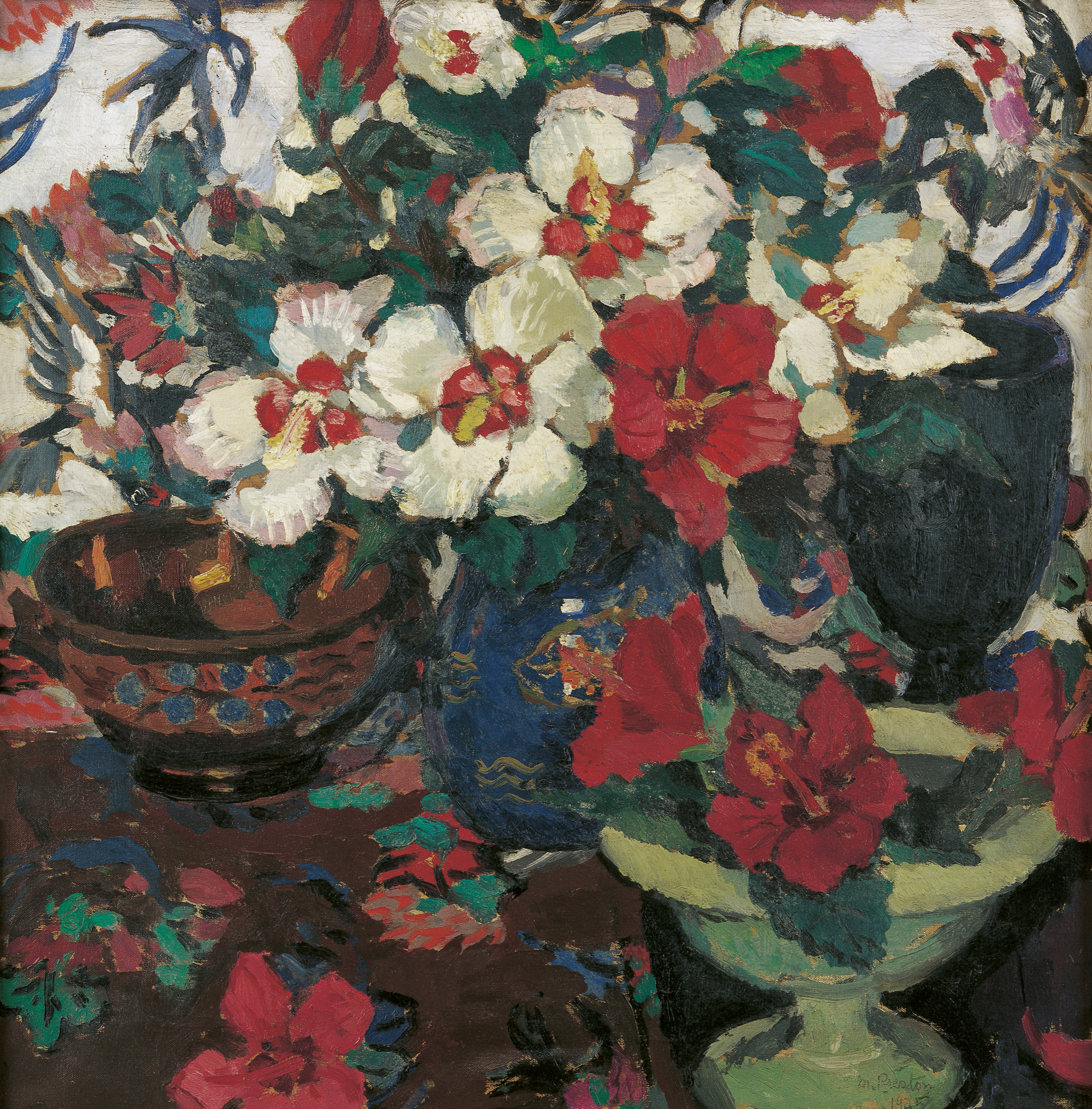
In 1930, Preston became the first woman artist commissioned by the Art Gallery of New South Wales to paint a self-portrait for their collection. This startlingly direct depiction presents a determined artist looking keenly out at the world; and in a newspaper review, she stated emphatically, but honestly, ‘I am a flower painter – and I am not a flower.’5 This resolute, unsentimental focus was already evident in her aesthetically complex paintings from the mid-1920s. As an indicator of their importance, a number of Phlox’s companion paintings from 1925 are now housed in important collections including: Still life and Study in white (National Gallery of Australia); White and red hibiscus (Art Gallery of South Australia); The green plant (Ledger Collection, Benalla Gallery); Pink Hibiscus (Wesfarmers); and Strelitzia (National Gallery of Victoria). Phlox is one of the few remaining in private hands from this pivotal stage in Preston’s career.
1. Preston, M., ‘From eggs to Electrolux’, Art in Australia, Ure Smith, Sydney, 3rd series, no. 22, 1 December 1926, non-paginated
2. Preston, M., ‘Why I became a convert to modern art’, Home: An Australian Quarterly, vol. 4, no. 2, June 1923, p. 20
3. Preston, M., ‘Aphorism 46’, in Gellert, L. and Ure Smith, S. (eds.), Margaret Preston: recent paintings 1929, Art in Australia Ltd., Sydney, 1929
4. See Edwards et al., Margaret Preston, Art Gallery of New South Wales, Sydney, 2005, p. 116
5. ‘“I am not a flower”. Mrs Preston’s Art Gallery Portrait: the modern artist.’, Sun, Sydney, 6 April 1930, ‘Women’s supplement’, p. 6
ANDREW GAYNOR
